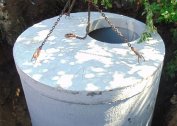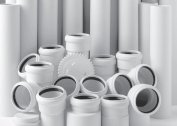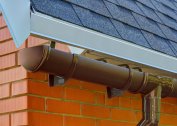The cesspool is one of the most important elements of the communal system of a country house. Sewer pipes are suitable for it, through which sewage is discharged. Wastewater goes into a tank and is divided into several fractions: water, dirt and sludge. Also in stock there is a share of fatty suspensions that come from the kitchen and bathroom.
Fat hazard
 Experts advise cleaning the cesspool at least once a year. Otherwise, fat may accumulate on the walls of the tank. This is fraught with dangerous consequences:
Experts advise cleaning the cesspool at least once a year. Otherwise, fat may accumulate on the walls of the tank. This is fraught with dangerous consequences:
- Clogged drain pipes. All sewage and water enter the cesspool through a drain pipe system. In septic tanks, there is also an additional pipe that removes excess fluid into the soil from the tank. If these components are left unattended, a normal blockage forms. The pipes will no longer allow fluid to flow through and it can go into the house.
- Reducing the useful volume of the tank. Rarely cleaning the cesspool can lead to severe hardening of the grease and sludge layer. In particular, the fat layer will accumulate on the walls of the container, and it will no longer be possible to wash off or remove it with a suction machine. Because of this, the cesspool will fill up faster. Owners will have to turn to the services of scavengers more often.
- An accumulation of bacteria and an unpleasant odor. Fat is an excellent breeding ground for microorganisms. If tenants rarely clean a septic tank or cesspool, then sooner or later they will smell an unpleasant odor.
These are the main troubles that may arise due to the irresponsible attitude to cleaning the cesspool.
If you do not want the described effects, clean the cesspool yourself. It can be carried out in two ways.
Chemical cleaning methods
 The chemical method is the simplest and most affordable. With the help of chemistry, you can perform cleaning without the involvement of third-party specialists. To clean the cesspools, chemistry is used based on:
The chemical method is the simplest and most affordable. With the help of chemistry, you can perform cleaning without the involvement of third-party specialists. To clean the cesspools, chemistry is used based on:
- nitrates;
- ammonium compounds;
- acids;
- formaldehyde.
The latter component is used less often due to its high toxicity. Experienced suckers prefer nitrate agents as the most affordable and safe.
This cleaning method is based on a chemical reaction in which fat is broken down into simple components. The entire workflow can be divided into several stages:
- Reagent preparation. Thoroughly dilute the product according to the instructions. You can not make too concentrated a solution, in the hope that the contents of the tank will dissolve faster. A saturated product can not only corrode fat, but also damage the container or oxidize the pipes.
- The resulting solution is poured into the main tank and closed with a lid. It is important to leave a small air outlet. Otherwise, excessive pressure forms in the cesspool, which can lead to the destruction of the walls of the pit, as well as the deformation of the pipes.
- The pit is left closed for 3-4 hours. With a tank volume of more than 2 cubic meters, it is worth increasing the working time of the reagent to 6 hours. It is advisable not to approach the pit for this period. During a chemical reaction, harmful substances may be released into the air. It is also worth leaving children and pets in the house.
- After the expiration of the pit open. The resulting liquid is pumped using a drainage or fecal pump into a prepared container or pit.
Observe safety precautions during cleaning. Wear a respirator and protective gloves. Before buying chemistry, calculate the amount of substance you need based on the volume of the cesspool.
Mechanical cleaning methods
 The Zolotar method or mechanical cleaning implies that a person will do all the work of removing fat from the walls of the tank.It is desirable that he was not alone, since alone the speed of work will decrease on average one and a half times.
The Zolotar method or mechanical cleaning implies that a person will do all the work of removing fat from the walls of the tank.It is desirable that he was not alone, since alone the speed of work will decrease on average one and a half times.
For mechanical cleaning you will need:
- drainage or fecal pump;
- long hose;
- hard brush;
- shovel or metal scoop;
- sewage discharge tank or foundation pit;
- bucket.
The mechanical cleaning method in steps:
- Water with sewage is pumped out of the cesspool using a fecal pump. The liquid is poured into a prepared tank or foundation pit. It is best to use a fecal pump with a grinder. He will better cope with the task and pump out more pollution than the drainage device.
- A man with a bucket and a brush descends into a "dry" tank. All fat, as well as silt, is cleaned from the walls and put into a bucket. His pass on the street partner. He takes the bucket to the landfill. Or pours it into a pit.
- After the first cleaning, the pit is filled with running water. The whole process is repeated anew, to the desired degree of purity of the tank. Usually, fat deposits on the walls of the pit are cleaned 2-3 times.
To enhance the effect, you can use chemistry. That is, alternate the chemical and mechanical cleaning methods. This way you can achieve better results in fewer cycles.
Problem prevention
To prevent cesspool cleaning from becoming a headache, do regular tank maintenance:
- Once every two months, open the lid and evaluate the visual condition of the pit. If a layer of fat over 0.5 is visible on the walls, then it’s time to clean it.
- Rinse sewer pipes occasionally with clogging aids. Such prevention will not only protect the drainage system, but also dissolve part of the fat deposits in the cesspool.
Also, for prevention, you can use ordinary baking soda and vinegar. Pour a few tablespoons of soda into the drain hole in the sink or bathtub and pour dry powder with 100 grams of vinegar. It is important to immediately plug the hole with a rag or cork, since a strong reaction will form from the chemical reaction and foam will go. The solution will literally burrow. It must be directed in the right direction, namely, in the drain.
The listed methods will help to extend the terms of service of the cesspool and will save the tank from excessive fat accumulations.


